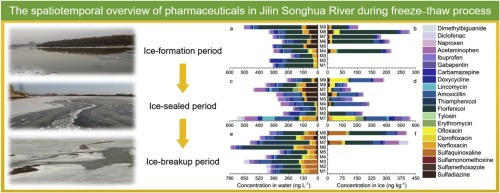当前位置:
X-MOL 学术
›
J. Hazard. Mater.
›
论文详情
Our official English website, www.x-mol.net, welcomes your
feedback! (Note: you will need to create a separate account there.)
Occurrence, distribution, and ecological risk of pharmaceuticals in a seasonally ice-sealed river: From ice formation to melting.
Journal of Hazardous Materials ( IF 12.2 ) Pub Date : 2020-01-20 , DOI: 10.1016/j.jhazmat.2020.122083 Liwen Zhang 1 , Siying Du 1 , Xun Zhang 2 , Guangze Lyu 1 , Deming Dong 1 , Xiuyi Hua 1 , Wenming Zhang 3 , Zhiyong Guo 1
Journal of Hazardous Materials ( IF 12.2 ) Pub Date : 2020-01-20 , DOI: 10.1016/j.jhazmat.2020.122083 Liwen Zhang 1 , Siying Du 1 , Xun Zhang 2 , Guangze Lyu 1 , Deming Dong 1 , Xiuyi Hua 1 , Wenming Zhang 3 , Zhiyong Guo 1
Affiliation

|
Occurrence, distribution, and ecological risk of 21 pharmaceuticals in the Jilin Songhua River were investigated during its freeze-thaw periods, including ice formation, sealed, and breakup. Florfenicol was the most abundant pharmaceutical, with mean concentrations of 123.4 ± 61.1 ng L-1 in water and 73.8 ± 66.3 ng kg-1 in ice. Sulfadiazine occurred at a higher mean concentration in downstream areas (45.6 ± 7.4 ng L-1) than in upstream areas (0.7 ± 0.7 ng L-1). Most pharmaceuticals appeared in relatively high concentrations in water during the ice-breakup period. Complex factors including pharmaceutical usage patterns, ice-regulated photodegradation, biodegradation, water flow, and freeze-concentration effects, as well as the release of pharmaceuticals from ice, were responsible for the temporal variation of pharmaceuticals. Pseudo-ice/water distribution coefficients showed the distribution of pharmaceuticals in ice and demonstrated the effects of their release from the ice on their temporal variations. Most pharmaceuticals posed a risk to algae; of these, amoxicillin exhibited the highest risk. In addition, thawing increased the concentration of thiamphenicol in water, which elevated its ecological risk level. The findings suggest that the pharmaceuticals retained in ice should be considered with regard to regulating pharmaceuticals' temporal variations in seasonal ice-covered rivers during the freeze-thaw process.
中文翻译:

在季节性的冰封河中,药品的发生,分布和生态风险:从冰的形成到融化。
对吉林松花江冻融期间21种药剂的形成,分布和生态风险进行了调查,包括结冰,密封和破裂。氟苯尼考是最丰富的药物,在水中的平均浓度为123.4±61.1 ng L-1,在冰中的平均浓度为73.8±66.3 ng kg-1。磺胺嘧啶在下游地区(45.6±7.4 ng L-1)的平均浓度高于上游地区(0.7±0.7 ng L-1)。在破冰期间,大多数药物在水中的浓度都较高。复杂的因素包括药物的使用方式,受冰调节的光降解,生物降解,水流和冷冻浓缩作用以及药物从冰中的释放,这些都是造成药物时间变化的原因。假冰/水的分配系数显示了药物在冰中的分布,并证明了药物从冰中释放对其时间变化的影响。多数药物对藻类构成威胁。其中,阿莫西林的风险最高。此外,解冻增加了水中甲砜霉素的浓度,从而提高了其生态风险水平。研究结果表明,应考虑保留在冰中的药物,以调节冻融过程中季节性冰雪覆盖的河流中药物的时间变化。此外,解冻增加了水中甲砜霉素的浓度,从而提高了其生态风险水平。研究结果表明,应考虑保留在冰中的药物,以调节冻融过程中季节性冰雪覆盖的河流中药物的时间变化。此外,解冻增加了水中甲砜霉素的浓度,从而提高了其生态风险水平。研究结果表明,应考虑保留在冰中的药物,以调节冻融过程中季节性冰雪覆盖的河流中药物的时间变化。
更新日期:2020-01-21
中文翻译:

在季节性的冰封河中,药品的发生,分布和生态风险:从冰的形成到融化。
对吉林松花江冻融期间21种药剂的形成,分布和生态风险进行了调查,包括结冰,密封和破裂。氟苯尼考是最丰富的药物,在水中的平均浓度为123.4±61.1 ng L-1,在冰中的平均浓度为73.8±66.3 ng kg-1。磺胺嘧啶在下游地区(45.6±7.4 ng L-1)的平均浓度高于上游地区(0.7±0.7 ng L-1)。在破冰期间,大多数药物在水中的浓度都较高。复杂的因素包括药物的使用方式,受冰调节的光降解,生物降解,水流和冷冻浓缩作用以及药物从冰中的释放,这些都是造成药物时间变化的原因。假冰/水的分配系数显示了药物在冰中的分布,并证明了药物从冰中释放对其时间变化的影响。多数药物对藻类构成威胁。其中,阿莫西林的风险最高。此外,解冻增加了水中甲砜霉素的浓度,从而提高了其生态风险水平。研究结果表明,应考虑保留在冰中的药物,以调节冻融过程中季节性冰雪覆盖的河流中药物的时间变化。此外,解冻增加了水中甲砜霉素的浓度,从而提高了其生态风险水平。研究结果表明,应考虑保留在冰中的药物,以调节冻融过程中季节性冰雪覆盖的河流中药物的时间变化。此外,解冻增加了水中甲砜霉素的浓度,从而提高了其生态风险水平。研究结果表明,应考虑保留在冰中的药物,以调节冻融过程中季节性冰雪覆盖的河流中药物的时间变化。











































 京公网安备 11010802027423号
京公网安备 11010802027423号